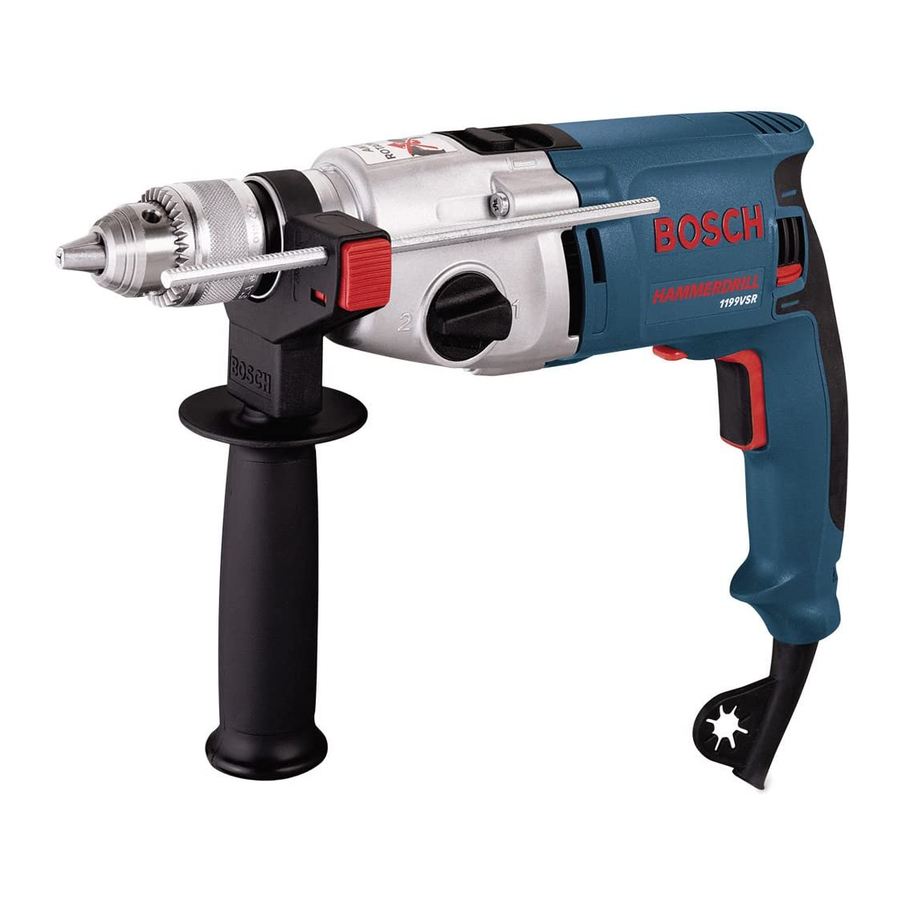Bosch 1199VSR - NA VSR 1/2" Dual Torque Hammer Drill Instrukcja obsługi/bezpieczeństwa - Strona 4
Przeglądaj online lub pobierz pdf Instrukcja obsługi/bezpieczeństwa dla Wiertarka Bosch 1199VSR - NA VSR 1/2" Dual Torque Hammer Drill. Bosch 1199VSR - NA VSR 1/2" Dual Torque Hammer Drill 33 stron. Bosch operating/safety instructions hammer drill 1199vsr
Również dla Bosch 1199VSR - NA VSR 1/2" Dual Torque Hammer Drill: Skrócona instrukcja obsługi (25 strony)

Position yourself to avoid being caught
between the tool or side handle and walls
or posts. Should the bit become bound or
jammed in the work, the reaction torque of
the tool could crush your hand or leg.
If the bit becomes bound in the
workpiece,
release
immediately, reverse the direction of
rotation and slowly squeeze the trigger to
back out the bit. Be ready for a strong
reaction torque. The drill body will tend to
twist in the opposite direction as the drill bit
is rotating.
Do not grasp the tool or place your hands
too close to the spinning chuck or drill bit.
Your hand may be lacerated.
Do not use the switch "Lock-ON" feature
in situations where drill bit binding is
likely. (For example: just before the bit is
ready to break through the material,
anytime when using a "Hole Saw", auger
bits........ etc.) When the bit binds, the drill's
body will twist or kick-back in opposite
direction and the release of the trigger
"Lock-ON" may be difficult.
Be aware of the location and setting of
the switch "Lock-ON" button. If the switch
is locked "ON" during the use, be ready for
emergency situations to switch it "OFF", by
first pulling the trigger then immediately
releasing it without pressing the "Lock-ON"
button.
When installing a drill bit, insert the shank
of the bit well within the jaws of the
chuck. If the bit is not inserted deep
enough, the grip of the jaws over the bit is
reduced and the loss of control is increased.
Do not use dull or damaged bits and
accessories. Dull or damaged bits have a
greater tendency to bind in the workpiece.
When removing the bit from the tool avoid
contact with skin and use proper
protective gloves when grasping the bit or
accessory. Accessories may be hot after
the
trigger
prolonged use.
Check to see that keys and adjusting
wrenches are removed from the drill
before switching the tool "ON". Keys or
wrenches can fly away at high velocity
striking you or a bystander.
Do not run the drill while carrying it at
your side. A spinning drill bit could become
entangled with clothing and injury may
result.
WARNING
!
grinding, drilling, and other construction
activities contains chemicals known to
cause cancer, birth defects or other
reproductive harm. Some examples of
these chemicals are:
• Lead from lead-based paints,
• Crystalline silica from bricks and cement
and other masonry products, and
• Arsenic and chromium from chemically-
treated lumber.
Your risk from these exposures varies,
depending on how often you do this type of
work. To reduce your exposure to these
chemicals: work in a well ventilated area,
and work with approved safety equipment,
such as those dust masks that are specially
designed to filter out microscopic particles.
-4-
Some dust created by
power sanding, sawing,
